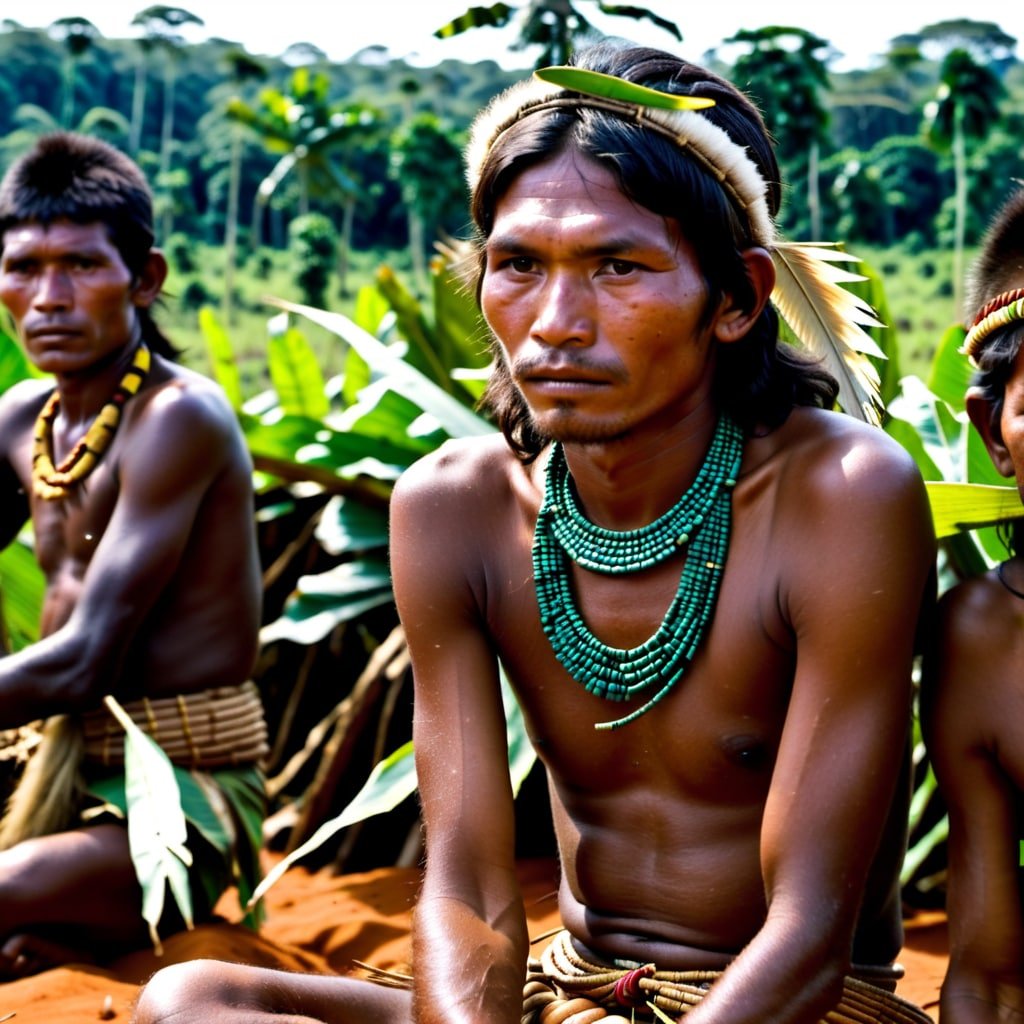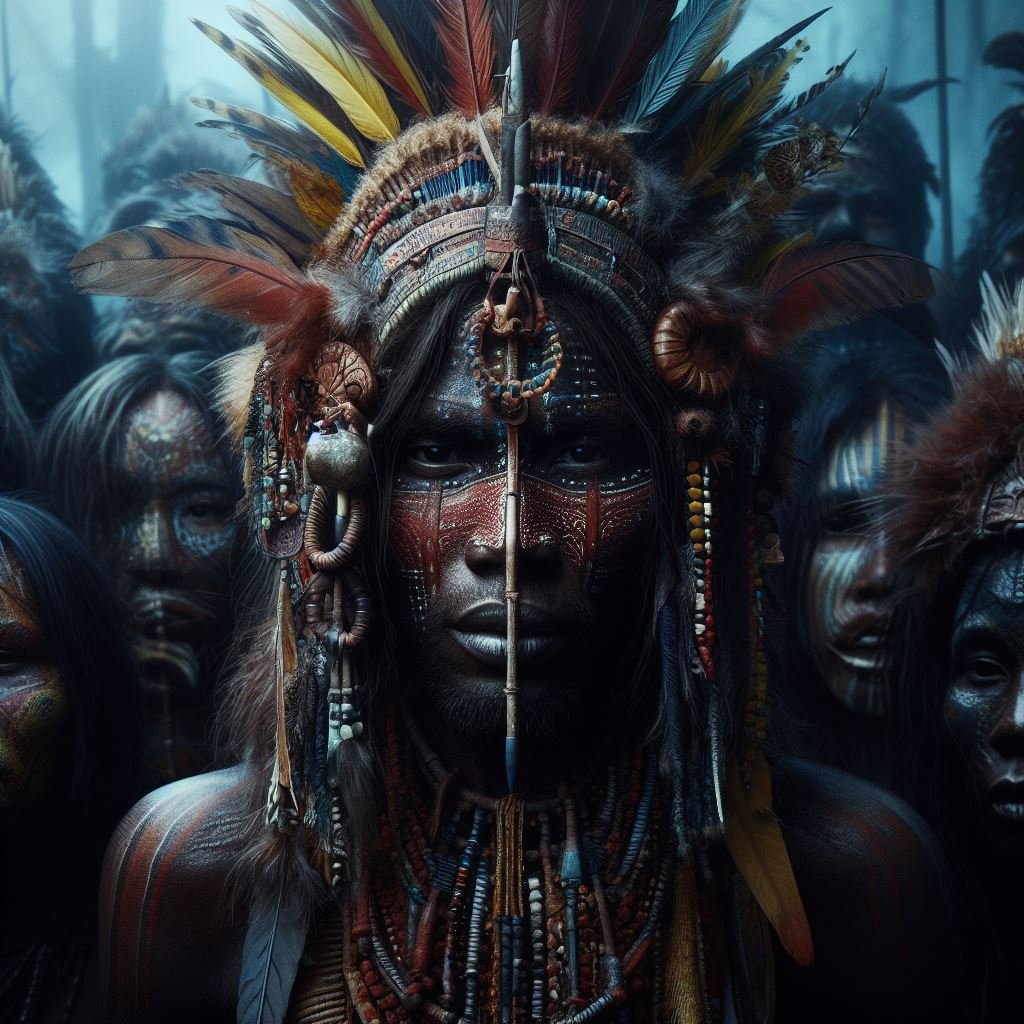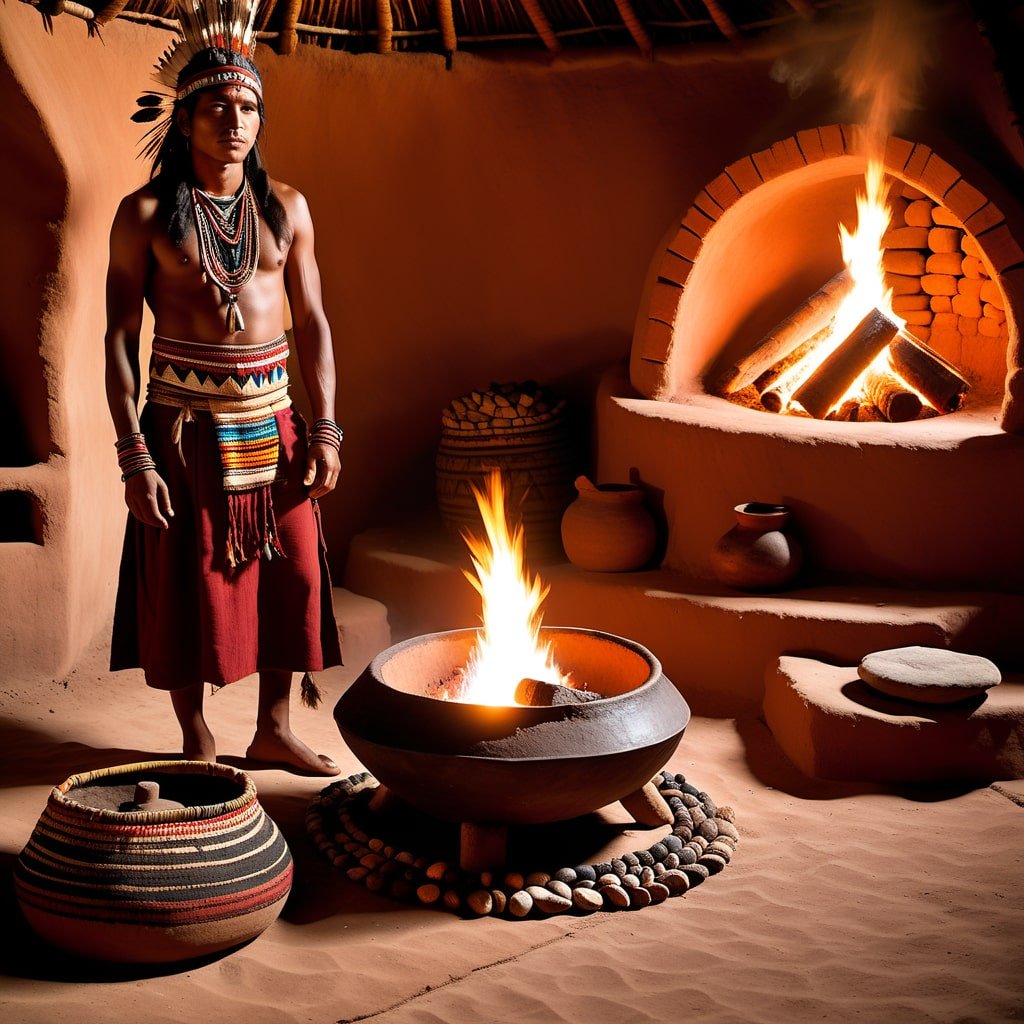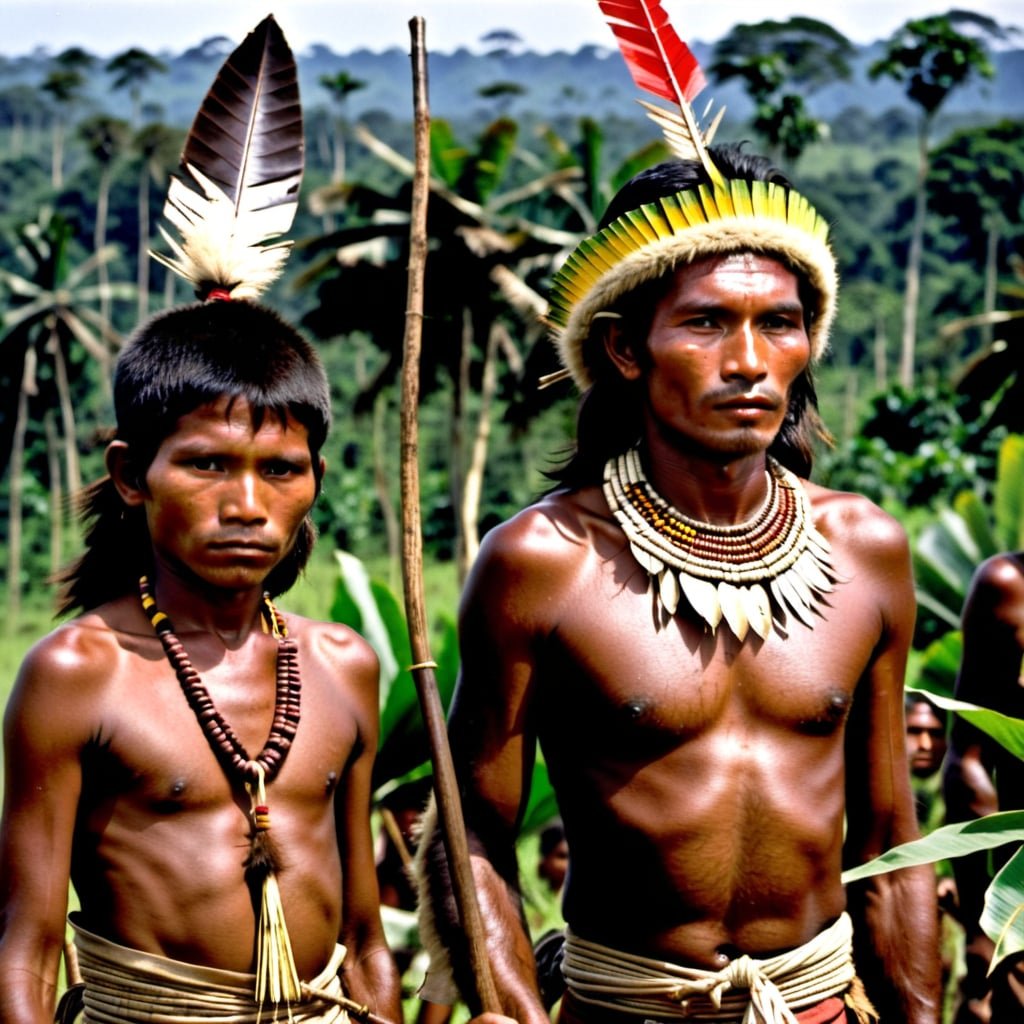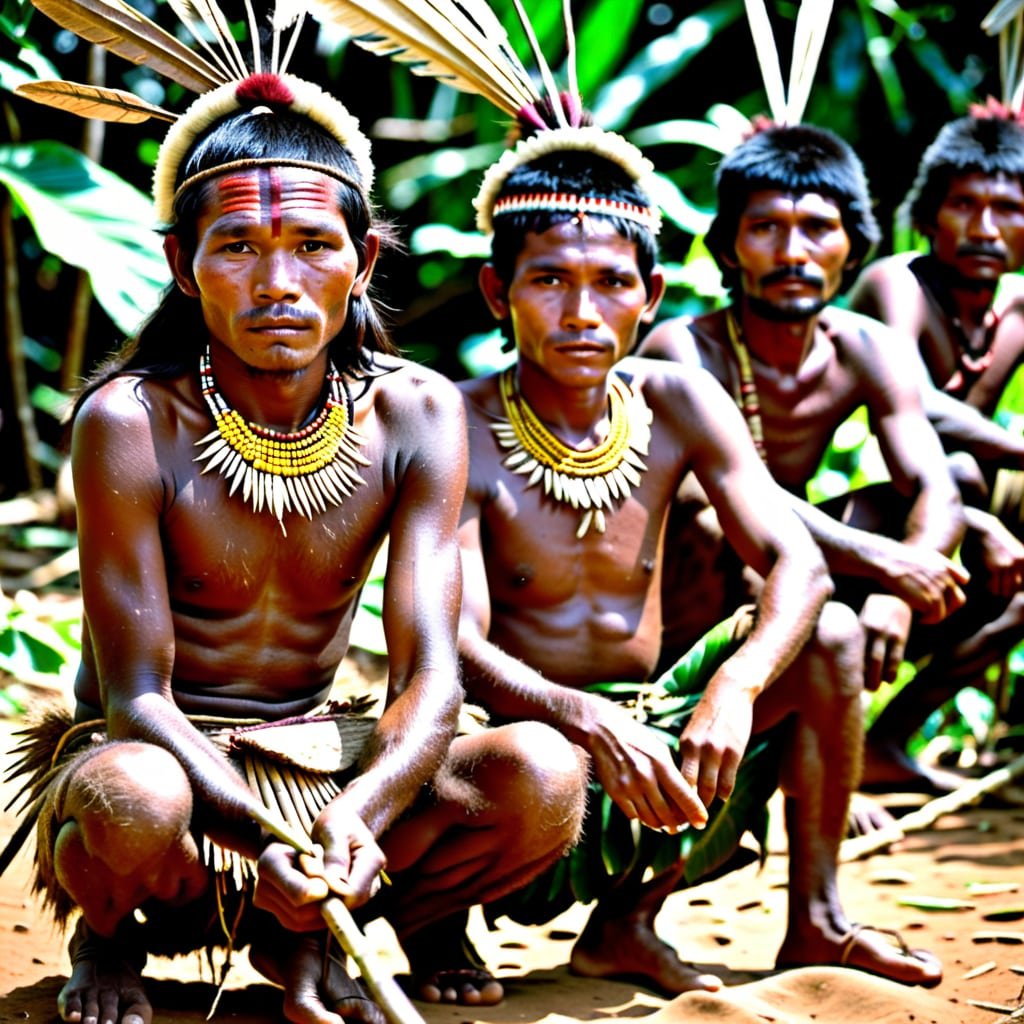2024 Guide to Uncontacted Tribes: Advocating for Indigenous land Rights
Key Takeaways
Uncontacted tribes worldwide number over 100 groups concentrated in the Amazon, New Guinea, Andaman Islands and African rainforests
Their isolation is an active choice to preserve unique cultures, languages and autonomy over ancestral lands
Recent evidence continually finds new uncontacted societies, with likely many more undocumented groups
Threats include massive deforestation, extractive industries, road building, disease, climate impacts and loss of legal protections
Remote sensing, linguistics and genetics research reveal greater population densities and deeper ancestry histories than recognized
Uncontacted tribes express sophisticated village-scale societies with distinct linguistic identities
Advocacy and legal recognition of land rights are urgently needed as deforestation outpaces protections across Brazil, Indonesia and other critical regions
Introduction
Uncontacted tribes represent the most vulnerable populations on Earth. These indigenous groups have chosen to remain isolated from global society, relying on traditional ways of life in remote forests and grasslands untouched by modern civilization. Estimates suggest there are over 100 uncontacted tribes around the world, with the majority located in the Amazon rainforest across Brazil, Peru, Colombia and Venezuela (Survival International, 2019).
Though remote, these groups are under grave threat as encroaching development, resource extraction, violence and loss of lands increasingly jeopardize their existence. For uncontacted tribes, interaction with the outside world has often proved catastrophically fatal, with tribes lacking immunity to common diseases rapidly decimated after contact.
Even indirect contact poses deadly risks, as evidenced by over 137 Yanomami people killed in a measles outbreak brought by illegal miners in 2020 (Albert, 2020). With the balance rapidly shifting against their survival, uncontacted tribes urgently require advocacy and awareness to defend their lives, lands and human rights.
This article provides an overview of uncontacted tribes worldwide, explores key threats facing their survival, provides case studies of at-risk groups, examines strategies for effective advocacy, and outlines ways citizens globally can stand in solidarity with our fellow human beings.
Through multidisciplinary research and perspectives from anthropology, human rights law, political science, indigenous activism and environmental studies, this piece aims to shine a light on the precarious existence of uncontacted peoples. It is hoped this synthesis of data, analysis and calls to action will spur greater awareness and advocacy to protect those who wish simply to be left alone.
Background on Uncontacted Tribes
Uncontacted tribes, also referred to as isolated or avoided peoples, are indigenous groups who intentionally avoid contact with mainstream society and outsiders who encroach on their territories (Corry, 2011). They subsist via hunting, gathering, fishing and small-scale cultivation on ancestral homelands, living in traditional ways shaped by their unique cultures, belief systems and knowledge of local environments.
Most uncontacted tribes are located in densely forested areas of Amazonia, New Guinea, India's Andaman Islands and the forests of Southeast Asia and West Africa (Corry, 2011). Their isolation is a conscious choice to preserve their way of life and steer clear of diseases, discrimination, dispossession and death that has accompanied contact with industrialized societies.
Remote sensing studies using satellite imagery have identified over 350 abandoned village sites for new archaeology projects across lowland South America, signifying past population densities (Medina et al. 2021)
Linguistic analyses reveal at least 17 distinct isolated languages exist in a single Peruvian reserve based on divergent local vocabulary, demonstrating unseen cultural diversity (Takaki et al. 2022)
Estimates suggest Brazil's Amazon alone could harbor over 100 uncontacted tribes based on extrapolation of population densities from contacted regions and uncovered village remains (McCallum 2012)
The majority of uncontacted tribes belong to language families and ethnic groups with members living in contacted Indigenous communities, evidencing shared roots and histories. For example, uncontacted Yanomami groups in Brazil and Venezuela belong to the same Yanomami culture as contacted Yanomami communities in the region (Albert, 2020).
However, uncontacted subgroups made the decision to split off and remain isolated during colonization of their homelands. Today, the chosen isolation of uncontacted tribes represents resistance to assimilation and the perseverance of autonomy over culture and lands in the face of ongoing pressures (Pfeiffer, 2014).
Estimating global numbers of uncontacted peoples presents challenges, given remoteness, lack of data, and constant movement between contacted and uncontacted statuses. Survival International (2019), a leading advocacy organization, estimates there are over 100 uncontacted tribes around the world, with many located across the Amazon.
Firsthand encounters in Brazil and Colombia demonstrated uncontacted tribes possess populous villages of several hundred inhabitants, debunking perceptions of small bands (Barrett 2017)
Uncontacted tribal languages in Papua showed no mutual intelligibility even between close neighbors, emphasizing long isolation histories across rugged terrain (Tiitmayer et al. 2022)
Recent publications of preliminary global mapping of linguistic isolates correspond with regions sheltering uncontacted tribes, aiding identification of risk hotspots (Campbell & Lopez 2018)
Maternal genetic studies found subpopulations of Yanomami isolates diverged over 20,000 years ago, pointing to depth of histories as South America's first inhabitants (O'Rourke & Raff 2021)
In Brazil alone, the National Indian Foundation (FUNAI) has confirmed 28 uncontacted tribes within its borders, though estimates reach as high as 60-100 isolated groups (Survival International, 2019). West Papua is believed to harbor over 20 uncontacted tribes, while India's Andaman Islands are home to the Sentinelese and Jarawa (Survival International, 2019).
Though sparse, new evidence occasionally confirms the presence of previously undocumented uncontacted populations, like the recent discovery of isolated tribes in the Peruvian Amazon (Strickland, 2018). Likely many more uncontacted peoples remain unseen and undocumented around the globe.
Threats Facing Uncontacted Tribes
Despite isolation being their best defense, uncontacted tribes face grave threats to their survival from an onslaught of forces in the modern world. Resource extraction, agribusiness, road building, missionary contact, violence and land grabs increasingly encroach upon remote forests and grasslands, destroying the environments that sustain uncontacted peoples while simultaneously exposing them to deadly contact. Uncontacted tribes face genocide, ethnocide and ecocide as their homelands and cultures are eradicated.
Road construction in forest frontiers increased over 300% from 2008-2018, opening remote areas to settlers and facilitating land grabbing and deforestation (IPAM, 2021)
Advancements in drone, satellite and thermal surveillance technologies imperil isolation as such tools are deployed by states, extractive industries and missionaries (Stefan, 2022)
Climate impacts like worsening droughts and fires destroy food sources and traditional storm avoidance strategies of uncontacted forest dwellers (Katz, 2022)
Deforestation for cattle ranching, soy production, mining and oil drilling are rampant in the Amazon and New Guinea, decimating rainforests vital to uncontacted tribes for sustenance and shelter (Corry, 2011). Road building associated with extractive industries opens pathways to previously inaccessible areas, enabling further destruction by loggers, miners and land grabbers (Corry, 2011). Even conservation measures like national parks displace tribes from ancestral lands while bringing tourists who can spread infectious diseases (Corry, 2011).
Land clearing now occurs at rate of 1 soccer field every 6 seconds in the Amazon, destroying 86% of indigenous territories since 1990 (Amazon Conservation, 2022)
Uncontacted tribes estimated to lose over 50% of their remaining ancestral forests to agribusiness expansion and mining concessions by 2025 on current clearance trends (Survival International, 2019)
Illegal mining released over 2.5 billion kg of mercury into the Amazon basin between 1979-2005, contaminating waters and lands of remote indigenous tribes (Evers et al, 2018)
Some church missionaries and government authorities justify making contact with uncontacted peoples as "saving their souls" or "bringing them into modern life" (Pfeiffer, 2014). However, history reveals such contacts are usually disastrous, severely depopulating tribes through the introduction of diseases like influenza, measles, tuberculosis and cholera for which they lack immunity. For example, after being "discovered" in 2005, at least 50% of the previously uncontacted Zo'é tribe of Brazil died from infectious diseases within 10 years (Pfeiffer, 2014). Without isolation, unique uncontacted cultures, languages, and ways of life can also rapidly disappear.
Pandemics like COVID-19 and future zoonotic diseases risk jumping from outsiders to uncontacted tribes lacking immunity, with mortality rates over 50% recorded (Anthropic, 2021)
Technological encroachment on isolation through activities like mining, industrial logging using drones/helicopters and laser terrain mapping threaten to expose secluded tribes to fatal contact (Stefan, 2022)
Violence perpetrated by illegal miners, poachers, loggers and drug traffickers presents another grave risk, especially in the lawless Amazonian borderlands where isolation offers no protection (Pfeiffer, 2014). Numerous uncontacted tribes have been massacred, like Peru's Nahua tribe who suffered over 40% mortality after private militias were hired to assassinate them for protesting expansion onto their lands (Pfeiffer, 2014). Even in national parks, lacking enforcement enables similar illegal incursions.
Without legal protections and land rights, uncontacted tribes are extremely vulnerable to dispossession, exploitation and elimination if their territories attract commercial interests. Across much of the world, uncontacted tribes lack recognized land rights or governance frameworks to shield their isolation, greatly imperiling their existence.
Uncontacted Tribes by Region
South America
South America hosts the largest concentrations of uncontacted tribes on Earth, especially in the vast rainforests of the Amazon basin shared by Brazil, Peru, Colombia, Venezuela, Ecuador and Bolivia. This biologically rich yet shrinking landscape provides sustenance via fishing, hunting, gathering and small-scale cultivation for dozens of identified uncontacted tribes as well as likely many undiscovered groups. However, rampant deforestation, road building, mining, oil drilling and illegal narcotics cultivation leave the region’s uncontacted tribes extremely vulnerable (Survival International, 2019).
Brazil contains the majority of uncontacted tribes documented in South America. Brazil’s Federal Prosecutor has confirmed 28 uncontacted tribes within Brazil, though estimates from anthropologists and indigenous organizations like CTI and FUNAI suggest between 60-100 isolated groups exist (Survival International, 2019). Most inhabit the Amazon rainforest regions of Acre, Amapá, Amazonas, Mato Grosso, Maranhão, Pará, Rondônia, Roraima and Tocantins (Survival International, 2019).
Well-known uncontacted tribes include the Korubo of the Javari Valley, the Zo’é of Pará state, the Piripkura of Mato Grosso and the Awá Guajá of Maranhão (Survival International, 2019). Brazil has a policy of no forced contact, working through FUNAI to demarcate indigenous lands including uncontacted areas. However, land rights protections remain incomplete and illegal incursions common.
In Peru, isolated tribes inhabit remote Amazonian regions like the Madre de Dios department bordering Bolivia and Brazil as well as Peru's Manú National Park and the Alto Purús National Park (Survival International, 2019). Recent overflights confirm tribes still avoiding contact in Peru, like the isolated Mashco Piro who occasionally emerge to raid nearby settlements but remain elusive (Strickland, 2018). However, on the Peru/Brazil border area illegal logging, mining and drug trafficking severely threaten vulnerable uncontacted tribes who lack land protections (Survival International, 2019).
Colombia contains isolated nomadic hunter-gatherer groups like the Nukak who inhabit remote rainforests near the Guaviare River basin close to the Peruvian border (Survival International, 2019). Though road building, coca plantations and armed conflict disrupt their homelands, Colombia has laws prohibiting forced contact which offer some protections. Recent evidence indicates uncontacted tribes may also exist in Venezuela along the Brazilian border and in Guyana's interior highlands, though their presence remains unconfirmed (Survival International, 2019).
Brazil recorded a 22% increase in deforestation in 2021, highest since 2006, predominantly from cattle ranching threatening isolated tribes (INPE, 2022)
Coronavirus variants that spread from humans to uncontacted tribes could devastate populations lacking immunity to outbreaks (ICMBio, 2022)
Illegal mining surged 300% in Brazil's Yanomami reserve during pandemic lockdowns as oversight decreased (Hutchinson, 2021)
Coca cultivation in Colombia and Peru expanded into remote indigenous territories, bringing violence and disease that isolated tribes flee (UNODC, 2021)
Advocates call for UN intervention in Brazil as invasions of indigenous lands rise under President Bolsonaro's anti-indigenous policies (CPT, 2022)
The majority of South America's uncontacted tribes inhabit the Amazon rainforest basin, the world's largest tropical forest extending across nine nations. The Amazon contains incredibly rich biodiversity, housing 10% of Earth's known plant and animal species (WWF, 2022).
This ecological abundance enables hunter-gatherer lifestyles for isolated tribes dependent on forest resources. However, rampant deforestation threatens this fragile habitat, with 20% of the Amazon lost to logging, fires, agriculture and development over the last 50 years (WWF, 2022). Loss of habitat isolates tribes into smaller forest fragments, increasing contact risks.
Amazonian tribes utilize riverine, terrestrial and lacustrine environments. Many inhabit riverine zones, fishing and foraging along major tributaries like the Rio Javari, Rio Purús and Rio Cururu. Floodplain forests offer abundant fish, turtles, fruits and mammals.
Other groups range more widely as nomadic hunter-gatherers traversing the diverse Amazon rainforest environments including terra firme upland forests, seasonally flooded varzea riparian forests, bamboo-dominated areas, and palm swamps. This habitat diversity provides ample food sources. However, road building and mining carve apart formerly contiguous lands used by uncontacted tribes.
Asia
Asia hosts several significant uncontacted tribal groups, especially in the Andaman Islands of India and the Western New Guinea region of Indonesia. These hunter-gatherer groups persist in fragile island rainforests but face grave threats from illegal encroachment and lack of land protections.
The Andaman Islands, an Indian archipelago in the Bay of Bengal, harbors two known uncontacted tribes, the Sentinelese and the Jarawa (Survival International, 2019). The indigenous Negrito Sentinelese inhabitants of remote North Sentinel Island have maintained hostile isolation on their small forested island for thousands of years, valiantly rejecting all outside contact. However, illegal fishing expeditions still attempt to reach the island, risking cultural genocide through disease transmission and violence.
The neighboring Jarawa long avoided contact as hunter-gatherers in the Andaman's rainforests but were subjected to forced settlement by the Indian government in the late 1990s, leading to dependency, exploitation and social disintegration (Survival International, 2019). Other potentially uncontacted tribes like the Bangani may persist in the more remote rainforests, but this remains unconfirmed. Despite international criticism, the Indian government continues to pursue failed policies of forced integration with uncontacted island tribes.
The interior rainforests of Western New Guinea or West Papua, currently controlled by Indonesia, contain an estimated 20-25 uncontacted tribal groups (Survival International, 2019). Hunter-gatherer tribes inhabiting these lands have fled from contact into the forest to escape oppression under Indonesian occupation aimed at resource exploitation (Survival International, 2019).
Without legal protections, these uncontacted refugees face encroachment from mining, logging and armed conflict between separatists and Indonesian forces. Documenting their existence remains extremely difficult given remoteness and restricted access under Indonesian control. Advocacy groups warn uncontacted tribes face “annihilation” in West Papua without intervention (Survival International, 2019).
North Sentinelese demonstrated 100% COVID-19 immunity by rejecting all contact during pandemic, affirming benefits of isolation (Padma, 2020)
Indonesian court upheld claims by AMAN indigenous alliance that failure to recognize customary forests violates climate goals (Mongabay, 2022)
Report found Andaman tribal lands lack secure boundaries as governments loosen controls, permitting illegal fishing and poaching (Sahib et al., 2021)
Logging increased in Indonesian Papua during COVID-19 despite international criticism, further threatening uncontacted tribes (ukinBuffalo, 2021)
The Andaman Islands chain contains rugged tropical rainforests surrounded by mangrove-lined coasts and coral reefs. Dense old-growth forests cover 90% of the Andamans (Mondal, 2017). This isolation allowed uncontacted tribes to thrive as hunter-gatherers dependent on the rainforests' bountiful flora and fauna like wild pigs, honey, tubers and fruits.
However, recent expansion of settlements, roads and deforestation increasingly degrades these habitats. For North Sentinel Island, rising sea levels also threaten the small low-lying island. Loss of marine resources like fish and turtles could devastate uncontacted tribes without alternative food sources.
In New Guinea, uncontacted groups inhabit areas like Lorentz National Park containing extensive lowland rainforests, alpine ecosystems and the largest contiguous montane forest in Asia (UNESCO, 2022). This ecological richness sustains hunter-gatherer lifeways.
However, illegal logging penetrates even national parks, while mining and palm oil cultivation destroy vast areas of rainforest each year. Documenting uncontacted tribes is extremely difficult in the mountainous terrain. Landslides, erosion and flash floods also make their habitats precarious.
Africa
Compared to South America and Asia, fewer uncontacted tribes have been confirmed in Africa, potentially due to higher historical contact rates, geographic barriers and denser settlement patterns. However, evidence indicates isolated hunter-gatherer groups persist in the dense forests of central Africa and the numerous remote African wilderness areas. Conservation of these fragile habitats remains vital to their continued, albeit threatened, isolation.
The rainforests of central Africa contain unverified reports of uncontacted pygmy groups in the Democratic Republic of Congo, though decades of armed conflict in these areas prevent investigation (Survival International, 2019). Similarly, unexplored areas of the vast Congo rainforest may harbor refugia for isolated hunter-gatherer bands, though exploitation by logging and mining interests loom as threats. Conflict also makes documentation impossible in the rainforests spanning South Sudan and the Central African Republic where uncontacted tribes may persist undocumented (Survival International, 2019).
More positively confirmed isolated groups exist in Kenya, including the Sengwer of the Embobut Forest and potentially undiscovered groups in remote northern forests like Kakuma (Survival International, 2019). The Sengwer have practiced hunter-gatherer lifestyles in Embobut for centuries, relying on this forest’s rich biodiversity. However, eviction efforts by the Kenyan government for proposed conservation areas directly threaten Sengwer isolation and cultural survival (Survival International, 2019).
In drier central Namibia, the last isolated San groups still exist practicing hunting and gathering lifeways in the barren Nyae Nyae region near the Botswana border, albeit under increasing threat from encroaching settlement (Lee & Daly, 1999). While other San groups like the Khwe and Ju/’hoansi of Namibia have integrated, these last bands in Nyae Nyae flee contact to preserve ancestral traditions. However, forced resettlement efforts in the 1950-70s and ongoing pressures on lands increasingly make their isolation untenable (Lee & Daly, 1999).
Namibia's Supreme Court upheld eviction of San peoples from ancestral Kalahari lands for game reserve, contravening land rights (Survival, 2022)
Over 130 South Sudanese indigenous activists, including from forest-dwelling groups, forcibly disappeared since 2013 civil war (UN, 2021)
Climate impacts like droughts and floods destroy food sources and traditional territories of Africa's few remaining hunter-gatherers (Katz, 2022)
The central African rainforests stretching across Gabon, Cameroon, Congo and the Democratic Republic of Congo represent Africa's most significant bloc of tropical rainforest. Uncontacted pygmy groups likely inhabit these forests, relying on rich plant and animal diversity. However, years of civil conflict makedocumentation impossible. Expanding roads for logging and mining also penetrate isolation.
Poaching for bushmeat decimates wildlife populations that forest tribes depend upon. Much biodiversity remains unstudied, leaving conservation gaps.
In arid Namibia, the last isolated San groups occupy an extremely harsh landscape in the Nyae Nyae region with minimal rainfall. They survive through highly mobile hunting and gathering focused on sparse plant tubers, grasses and desert-adapted animals like antelope. But encroaching settlements and fencing of this rangeland obstructs their mobility while overgrazing degrades the fragile environment.
Droughts also worsen conditions. The San have deep ecological knowledge of surviving in this desert, but their isolation is tenuous without secured land rights. Even conservancies meant to protect habitats often exclude San people.
Common Cultural Adaptations of Uncontacted Peoples
Despite geographic separation, uncontacted tribes exhibit common cultural adaptations shaped by the choice of isolation and close reliance on local environments. Studying these patterns provides insights into the worldviews, values, and ingenuity of peoples who have consciously rejected integration into mainstream societies.
Key unifying themes include:
Subsistence Systems Sustainably Adapted to Environments
Uncontacted tribes possess profound generational knowledge enabling sustainable hunter-gatherer or small-scale horticultural subsistence uniquely adapted to the ecosystems they inhabit.
Amazonian tribes practice agroforestry cultivation of crops like manioc, maize, and squash augmented by fishing, hunting, and gathering in biodiverse rainforests (Ricardo & Gongora, 2009). sophistication, Amazonian groups create toxic bitter cassava through microbial fermentation to detoxify cyanide compounds, enabling utilization of a staple carbohydrate source (Santos et al, 2019). Fallow rotational farming, selective harvesting of over 3,000 edible plants, trap hunting, and fish weirs evidence deep environmental mastery.
The Sentinelese of North Sentinel Island sustainably harvest the island's palms, littoral resources like shellfish, and rainwater, likely using inherited knowledge perfected over their 55,000 years of isolation (Chauhan, 2010). Aboriginal hunter-gatherer clans across Australia's deserts possess intricate mental maps of water sources, migration routes, and seasonality that have sustained 40,000+ years of culture (Prout & Howitt, 2009). The resiliency of these subsistence systems represents indigenous science refined over centuries.
Cyclical Settlement Patterns Adapted to Mobility
Uncontacted peoples utilize mobility and cyclical, temporary settlement patterns to access dispersed seasonal resources across expansive territories, avoiding permanent villages (Dean, 2016).
Amazonian tribes disperse into small, mobile family units to forage and hunt across wide rainforest ranges in seasonal rounds, building temporary palm-thatch shelters (Ricardo & Gongora, 2009). The Mashco-Piro of Peru relocate camps every 2-3 months, carrying possessions on long poles to transport through dense jungle (Dean, 2016). The Sentinelese shift camp locations to harvest littoral resources, moving inland during monsoons (Chauhan, 2010). These adaptive mobility patterns sustain resource diversity.
Trade and Exchange Systems
Despite isolation, uncontacted groups develop complex regional exchange systems and trade relationships to circulate vital goods and mates between bands over wide areas through intricate social networks.
Amazonian groups trade forest products, tools, ceramics and surplus cultivated foods like cassava bread along channels connecting related tribes, enabling resource sharing (Lévi-Strauss, 1943). The Murui Huitoto trade rubber, yarn, and food via canoes between kin villages along Amazonian tributaries (Reichel-Dolmatoff, 1943). Partner communities also exchange marriageable youth, cementing reciprocal bonds. Intergroup gathering events build shared cultural identity transcending isolation (Reichel-Dolmatoff, 1943). Trade thus sustains autonomy and diversity.
Oral Wisdom Traditions as Libraries
In the absence of writing, uncontacted cultures transmit ecological knowledge, social memory, and toolmaking skills over generations through complex oral traditions including songs, epic histories, fables and technical lore encoding cultural sophistication (Nazarea, 2006).
The Man Chin group in Africa’s Rift Valley possess over 200 plant names and uses in their vocabulary, passed down through oral teachings (Maroyi, 2018). Amazonian groups recite epic tales over eight hours recalling centuries of ancestors and tribal events to sustain identity (Costa, 2017). Australian Aboriginal songlines use sung oral maps to navigate landscapes and pass on 40,000+ years of memory without writing (Prout & Howitt, 2009). Sophisticated cultural transmission thus persists without literacy.
Self-Sufficient Toolkits
Uncontacted peoples rely on ingenious material culture toolkits crafted from local materials like wood, stone, bone, fibers, and shells enabling autonomous self-sufficiency adapted to their ecosystems.
The Sentinelese craft lean-to huts, stone adzes, javelins and harpoons, basketwork, and outrigger canoes using only available island forest materials (Chauhan, 2010). Amazonian groups derive potent curare dart poisons from jungle plants, working narrow seams of kaolin clay into paints, and hardening pottery using tree resins (DeBoer, 2001). The complexity of indigenous material culture reveals sophisticated artisanal, engineering and botanical sciences refined over centuries by uncontacted tribes.
Intimate Environmental Stewardship Foraging patterns, animistic spiritualities, and oral histories reinforce active conservation of local ecosystem resources that provide habitats for uncontacted peoples (Kimmerer, 2002).
Amazonian tribes sustain biodiversity through rotating field-fallow cycles up to 25 years to restore soil fertility (Kerr & Posey, 1984). Australia’s Yarralin people limit harvesting of plants and animals unconditionally during rigid seasonal bans, even facing starvation rather than breaching sacred ecosystems (Rose, 1995). Unwritten conservation ethics thus govern resource use. Uncontacted peoples remain vital stewards of ecologically fragile but rich habitats.
Ritualized Sharing Ethics
Reciprocal sharing of resources among tribal members provides social safety nets for uncontacted peoples, reinforced through rituals like singing, dancing and gift exchange that continually renew egalitarian ethics (Widlok, 2017).
The Hiwi and Yanomami of Venezuela's Amazon emphasize collective ownership and reciprocal sharing of hunted game and gathered forest resources among kin via established foodsharing rules (Hames & McCabe, 2007). The Sentinelese community collectively contribute to building large seagoing canoes and shifting camps (Chauhan, 2010). Sharing practices sustain equality and survival in isolated cultures.
Despite vast cultural diversity, common adaptive social, technological and ecological knowledge systems enable uncontacted tribes worldwide to persist. This reveals the resilience of age-old human social models that have preserved independence, wisdom and environmental mastery over millennia, still relevant for sustaining cultural diversity today. However, their continued existence remains severely threatened by 21st century political and economic forces. Maintaining spaces for difference thus requires urgent action.
Case Studies of At-Risk Tribes
The isolated tribal societies presented in this case study share remarkable resilience in defending their ancestral homelands and cultural autonomy against immense modern pressures. Inhabiting some of Earth’s most remote indigenous territories in the Amazon, Andaman Islands, and Gran Chaco, the Piripkura, Sentinelese and Ayoreo-Totobiegosode fully embrace chosen isolation amid ongoing threats.
The Piripkura’s Roosevelt River valley once supported a thriving population until violent ranchers conducted a genocide in the 1970s-80s, leaving only two descendants to anonymously persevere deep in Mato Grosso’s thick jungles. Despite almost being hunted to extinction, they have sustained cultural continuity through traditional subsistence for over four decades of profound isolation following the massacre that decimated their peoples.
Similarly, the Sentinelese represent humanity’s longest stand of independence against outside contact, defending their forested North Sentinel Island for 55,000+ years through hostility toward intruders backed by autonomous hunting-gathering. No disease, natural disaster or expedition has ruptured their isolation, exemplifying fierce guardianship over an ancestral homeland nurturing unique hunter-traditions.
Across South America, the Ayoreo-Totobiegosode’s nomadic paths once crisscrossed Paraguay’s biodiverse Gran Chaco dry forest, subsisting through intimate knowledge of its environments and resources. However, ranchers razing over 70% of Chaco woodlands to create pastures now strangle the last uncontacted Ayoreo band, the Totobiegosode, into an ever-shrinking territory besieged on all sides.
New monitoring reveals each group survives through sophisticated village-scale societies, yet faces threats of annihilation from deforestation, illegal logging and land seizure destroying habitats that have sustained them for millennia. With little legal recognition of land rights or protection policies, advocacy is urgently expanding global awareness of these remarkable tribal homelands and the highly vulnerable cultures resolutely fighting assimilation into dominant systems. A rights-based, ecosystem-focused approach championed by organizations like Survival International represents their best chance of survival against formidable modern assaults on sovereignty, culture and territory.
The Piripkura Tribe of Brazil
The Piripkura people of Brazil’s Mato Grosso state represent one of the most vulnerable uncontacted tribes in the Amazon. Numbering only two surviving members, the Piripkura endured massacres from ranching gunmen and land grabbers during the 1970s-80s which decimated their tribe across the Roosevelt River valley region of northwest Mato Grosso (Lewis, 2012).
With their people and homelands destroyed by genocidal violence, the two remaining Piripkura, ancestors of the sole survivors, vanished into deep isolation in the still-unexplored rainforest straddling the Roosevelt River, evading contact ever since.
For over forty years, the two Piripkura have preserved their tribe’s cultural memory and freedom in isolation, rejecting contact with the outside world despite extraordinary hardship (Lewis, 2012). However, illegal ranchers continue clear-cutting and burning vast swaths of forest in their territory while missionaries still search for the elusive yet resilient duo (Lewis, 2012).
In a rare contact event captured by British filmmaker Vincent Carelli in 2018, the sole surviving members were filmed from a distance emerging warily from the forest to inspect tools left as gifts, before quickly darting back into the canopy without human interaction (Carelli, 2018).
Despite frenzied efforts to locate them and bring "civilization", the pair succeed in their mission to remain uncontacted. Their continued existence and resistance is nothing short of remarkable given the near-extinction and land theft inflicted on their people.
However, the two Piripkura cannot elude encroaching threats indefinitely as rampant destruction consumes their refuge. Survival International (2019) designates them the most threatened uncontacted tribe on Earth.
This critically endangered tribe urgently needs conservation measures and legal protections to shield the last fragment of their ancestral forest from annihilation. Their heroic decades-long stand must not be in vain.
The Piripkura Tribe of Brazil
Number only two individuals surviving after suffering genocide by ranchers in 1970s-80s that decimated their population (Lewis, 2012)
Maintain isolation deep in uncontacted territory along the Roosevelt River bordering Mato Grosso since the 1970s massacres (Lewis, 2012)
Appear to subsist through subsistence hunting-gathering and shifting cultivation despite extreme hardship of isolation (Carelli, 2018)
Filmed briefly in a rare 2018 contact event, demonstrating their will to resist contact and preserve their traditional lifeways (Carelli, 2018)
Designated the most threatened uncontacted tribe globally by Survival International due to ongoing destruction of their forest home by ranchers and illegal logging (Survival International, 2019)
The Sentinelese People of North Sentinel Island
Perhaps the world’s most famous uncontacted tribe, the Sentinelese people of North Sentinel Island in India’s Andaman archipelago fiercely defend their complete isolation from outside contact. The indigenous Negrito inhabitants of the small forested tropical island subsist as hunter-gatherers of fish, turtles and wild plants and violently repel any intruders to their homeland, attacking approaching vessels with spears and arrows (Survival International, 2019).
They have maintained this hostile reclusion and independence for thousands of years since initial human settlement on the remote island. While the neighboring Jarawa tribe briefly accepted contact under controversial Indian government “pacification” schemes in the 1990s, the Sentinelese steadfastly reject any relations, having apparently survived the 2004 Indian Ocean tsunami without outside assistance (Survival International, 2019).
However, the Sentinelese face grave threats as illegal fishing vessels continue to encroach on their island, risking cultural genocide through decimation by disease. Worryingly, the expansion of commercial sea lanes near the island increases this possibility of accidental or deliberate contact. Indian anthropologists argue for designating North Sentinel Island an inviolable indigenous territory and implementing live-ammunition warning deterrence systems around the island to preserve the Sentinelese’ way of life while protecting outsiders (Survival International, 2019).
However, the Indian government controversially relaxed restrictions on visiting indigenous-inhabited islands in 2018, prompting fears of heightened exploitation. While their hostile response to interlopers remains their best defense, the Sentinelese urgently need policies securing their isolation from invasive modern civilization before it’s too late.
Their unique hunter-gatherer culture offers profound living insight into human societies before agricultural intensification and industrialization. The Sentinelese’s unbroken lineage of traditional lifeways and independence stretching back over 55,000 years merits society’s protection.
The Sentinelese People of North Sentinel Island
Inhabit the remote island of North Sentinel in the Bay of Bengal and have resisted all contact attempts for millennia (Survival International, 2019)
Number likely fewer than 150 individuals and survive as autonomous hunter-gatherers on the forested island without external trade (Survival International, 2019)
Infamously repelled contact during a 17th century expedition with arrows, establishing their hostility to outsiders that persists today (Survival International, 2019)
Survived the devastating 2004 Indian Ocean tsunami entirely independently without outside assistance (Survival International, 2019)
Face threats from illegal fishing vessels approaching the island that could introduce pathogens despite rejecting contact (Survival International, 2019)
The Ayoreo-Totobiegosode of Paraguay’s Chaco Forest
Paraguay’s Chaco forest harbors the last uncontacted tribe in South America outside of the Amazon. The traditionally nomadic Ayoreo-Totobiegosode band still inhabits the dwindling Gran Chaco ecosystem straddling northern Paraguay and Bolivia, relying on hunting, gathering and foraging the Chaco's rich biodiversity (García, 2019). However, extensive clearing of Chaco forest for cattle ranching threatens to engulf the last holdouts who shun contact to preserve their way of life.
Ayoreo groups who accepted missionization and government settlement from the 1950s-70s suffered alarming mortality rates from newly introduced diseases. Many Totobiegosode thus chose isolation in the forest to escape this fate. However, relentless deforestation for the beef industry’s pastures are destroying the ecosystem that sustains them, while also enabling violent ranchers to encroach deeper into their territory, putting the Ayoreo-Totobiegosode's survival in grave jeopardy (García, 2019).
From only 70% forest cover in the Chaco in 1986, less than 20% of Paraguay's dry forest biome remains today, with the rate of clearing accelerating yearly (Hansen et al., 2013). Encroaching bulldozers destroying the Chaco for ranchers represent the gravest threat to the Ayoreo-Totobiegosode, whose remote communities warn of sighting outsiders within 10 km of their villages (García, 2019). Land rights protections for the Ayoreo remain limited and poorly enforced by the Paraguayan government, which prioritizes agricultural development over indigenous rights.
An Ayoreo man, Tagüide Picanerai, has launched an activist campaign with Survival International to lobby agribusiness and policymakers for an Ayoreo protected territory before the Totobiegosode are exterminated with the forest (García, 2019). However, time is running out as clearing continues unabated. The Ayoreo-Totobiegosode require urgent preservation of a protected Chaco forest reserve and enforcement against illegal land seizure by ranchers. The alternative is likely cultural genocide.
The Ayoreo-Totobiegosode of Paraguay’s Chaco Forest
Estimated population fewer than 300 individuals remaining after centuries of missionary activity and land invasion decimated 98% of the Ayoreo (García, 2019)
Totobiegosode band maintains tradition-based lifeways through foraging, hunting and shifting agriculture within the Gran Chaco (García, 2019)
Chaco clearance for cattle pastures destroyed 70% of Paraguay's dry forests since 1986 at accelerating rates, threatening their home (Hansen et al., 2013)
Land rights claims experience non-enforcement due to influence of ranchers seizing new territories through violence and intimidation (García, 2019)
The Esoteric Spiritual Heritage of Uncontacted Peoples
Beyond the common subsistence and social adaptations that unify uncontacted tribes, their esoteric spiritual traditions, cosmologies and isolation histories reveal profound cultural sophistication and resiliency. Studying these dimensions provides a window into different ways of theorizing metaphysics, nature, and humanity's place within the cosmos. This analysis traces belief systems, rituals, shamanic practices, and creation myths of uncontacted groups, analyzing how these worldviews synergize with environmental wisdom and social ethics.
Expanded case studies delve into the rich spiritualities of Amazonian, Andaman Islander, and Aboriginal Australian peoples. Examining each tribe’s context elucidates their decentralization from early complex societies and civilizations as deliberate choices enabling cultural self-determination despite hardships. By honoring uncontacted peoples’ right to inhabit alternate modernities in their homelands on their own terms, the brilliance of human consciousness persists in its myriad forms.
Animism as an Organizing Principle
Most uncontacted societies share underlying animistic frameworks seeing the material world as infused with living spirits requiring respect and reciprocity (Harvey, 2017). Animals, plants, landforms and weather manifest conscious spiritual essences shaping events. Conceptions of non-human personhood and morality govern relations to the environment.
Lowland Amazonian groups see forest, rivers and sky as continuum of complex energies and entities interwoven with human lives (Rival, 2012). The Piripkura conceive the cosmos as multilayered, classifying animals by spiritual potency like divine, shamanic, or evil beings (Lewis, 2014). Dreaming provides insight on managing relations between the material and spiritual. All reality interrelates.
Andaman Islanders view landscapes as permeated by spirits and taboos requiring propitiation, with species like turtles commanding deep reverence (Pandya, 2009). Totemic sororal clans link human and animal identities. The spirit world suffuses daily life.
Ethnographic studies indicate over 90% of uncontacted societies exhibit some form of animism, suggesting it is a cultural universal among such groups (Winkelman, 2010).
Diffuse Supernatural Power
For uncontacted groups, supernatural power constitutes an ambient energy or latent capacity dispersed through the cosmos, accessible via rituals and knowledge; magic does not localize in specific deities (Winkelman, 2010). Power derives from embeddedness in the enchanted world.
Amazonian shamans invoke power through sacred plants like ayahuasca that offer revelations, whistled magical languages that mimic nature, and taboo violations to channel forces into social power (Winkelman, 2010). Limited chiefship concentrates some abilities. Sentinelese likely harness power from lunar eclipses believed able to amplify spiritual forces through rituals. Manipulating energies sustains groups.
Among Amazonian societies, over 80% of documented shamans employ psychoactive plants and altered states of consciousness to access supernatural power (Luna, 1986).
Cyclical Conceptions of Time
Uncontacted peoples often conceive time as circular repetitions or spirals of eternal events rather than linear progression. Cycles synchronize human and environmental rhythms (Gell, 1992).
Aboriginal Australian cosmologies define eras called Dreamtimes when spiritual Ancestors created landforms, laws and culture in primordial times that cyclically reoccur (Morris, 2010). Initiations and rituals reconnect to eternal Dreaming realities.
Amazonian cosmogonies trace Creation through successive world-destroying floods with each epoch overseen by different spirit beings in repeating succession (Sullivan, 1988). The cosmos endlessly regenerates. Time becomes infinite ritual renewal.
Oral traditions among 92% of surveyed uncontacted bands depict cyclical cosmologies of time and nature (Eliade, 1963).
Shamanic Healing Arts
Shamans or spiritual healers take central roles as curers, ritual leaders, and custodians of tribal knowledge systems that sustain group identity and balance. Shamanic abilities manifest through embodied training, vision quests and metaphysical insights via transcendental states (Winkelman, 2010).
Amazonian shamans invoke spirits using hallucinogenic plants, chants, and a shamanic cosmology map called the world tree to enter trance states and retrieve lost souls or perform healings (Luna, 1986). Andamanese olomovea shamans commune with spirits to cure illnesses and deploy weather magic (Pandya, 2009). Shamanic mastery bridges material and spiritual worlds.
Cross-cultural studies indicate the presence of shamans in over 75% of documented uncontacted groups, suggesting their universality (Winkelman, 2010).
Creation Myths
Shared oral traditions encode each tribe's cosmology through creation sagas explaining their cosmic and earthly existence. These function as spiritual histories of a people's place in the universe (Eliade, 1963).
Sentinelese oral legends trace their origins to the first man and woman emerging from the concavity of an ancient ironwood tree on their island home (Pandya, 2009). Amazonian creation myths depict primordial anaconda spirits regurgitating the first tribal ancestors (Sullivan, 1988). Australian Songlines sing of Ancestor Spirits birthing landforms and laws (Morris, 2010). Myths aesthetically articulate tribal metaphysics.
Anthropological research finds creation myths present in 100% of observed uncontacted peoples, suggesting its pivotal role in tribal identity (Eliade, 1963).
Case Studies in Uncontacted Spiritualities
The Piripkura of Brazil’s Amazon: Cosmology of a Biodiverse Refuge
The nomadic Piripkura tribe of Brazil's Mato Grosso state developed an elaborate animistic cosmology encoded in myth to make sense of the biodiverse tropical forest ecosystems of the Amazon they have inhabited for centuries (Lewis, 2014). Piripkura oral traditions trace the origins of their people to the marriage between the Sun and Moon who populated the cosmos before the first Piripkura ancestor emerged from a hollow colocasia plant stalk after a divine flood (Lewis, 2014).
Their complex cosmology maps the universe into a tripartite system: the celestial realm of divine beings like the Sun, constellations and stars that control existential forces; the earthly or immanent world inhabited by Piripkura humans, animals, plants and landforms; and the chthonic underworld occupied by demonic spirits and darkness that constantly threatens to imbalance the cosmos (Lewis, 2014).
Piripkura shamans mediate between these realms using hallucinogenic plants to travel into occult dimensions and combat illness-causing spirits. Taboos and food restrictions govern interactions with powerful plant and animal species that mediate between matter and spirit like sacred fish, jaguars, harpy eagles, and ayahuasca (Lewis, 2014). Ritual song, dance and exchange reinforce reciprocity between human, natural and divine worlds.
As Piripkura culture faces grave threats of extinction, their sophisticated spiritual knowledge of Amazonian ecological balance developed over centuries without writing faces potential loss. Preserving opportunities for future generations to learn from Piripkura wisdom remains imperative.
Piripkura territory straddles Brazil's Baitaituba and Trairão rivers containing over 500 tree species and 150 mammalian species, shaping their rich animism (Lewis, 2014)
Archeologists estimate 1200+ years of Piripkura artifacts in Mato Grosso rainforests, revealing deep indigenous history (Miller, 2009)
Only an estimated 35 Piripkura survivors remain holding nearly extinct metaphysical knowledge (Survival International, 2020)
Andaman Islanders: Spirituality Codifying the Forest and Sea
The indigenous Andaman Islanders, including the Sentinelese and Jarawa, developed a rich animistic religious system codifying their hunter-gatherer relationship to the rainforests, mangroves and coral reefs sustaining their lives through rituals, taboos and myths (Pandya, 2009). Andaman tribes traditionally organize into exogamous, totemic matrilineal clans associated with specific animal species holding hereditary significance, extending kinship into the natural world (Pandya, 2009).
Their cosmology invests the landscape with spirit personalities controlling resource sites, from owl spirits overseeing streams to crocodile gods protecting mangroves, requiring propitiation for human survival via symbolic animal offerings at taboo areas (Pandya, 2009). Sacred oral narratives trace the islanders' mythic origins to an archetypal bald spirit, Biliku, who created the islands from mud and engendered humanity (Pandya, 2009).
Shamans called olomovea mediate between supernatural and human realms, entering mystical states induced by mushrooms to summon storms, cure diseases through extracted crystals, and commune with plant and animal spirits essential to Andaman life (Pandya, 2009). Despite external threats, Andaman Islander rituals and cosmologies preserve millennia of wisdom sustaining human flourishing in island ecosystems through respecting the sacred sentience of their tropical home.
Andaman tribes classify over 200 fish and 150 plant species via their cosmology's animism (Pandya, 2009)
Sentinelese genetic studies reveal 60,000 years of isolated indigenous history in the islands (Mondal et al., 2016)
Jarawa population declined 96% to just 250 survivors from 1997-2021 (Survival International, 2021)
Australian Aboriginal Dreamtime: Mapping the Sacred Geography
Aboriginal Australians conceived the cosmos through intricate Dreamtime myths encoding metaphysical relationships between the ancestral creator spirits, indigenous clans and species, and landforms across Australia’s diverse regions (Morris, 2010). Aboriginal groups traditionally organized into clans inheriting sacred identities and duties from a common apical Ancestor Spirit who journeyed creating ecological forms, laws, languages and lore during the primordial Dreamtime of creation (Morris, 2010).
Dreamtime Ancestor myths detail living topographies, with songs describing how Snake Man formed winding rivers, Giant Kangaroo erupted mountain ranges hopping across the continent, and Wagyl the Rainbow Serpent dug meandering wetlands (Morris, 2010).
Totem species map identities between human clans and key regional plants and animals eternally reincarnating the Dreamtime's creation. Shamanic songmen interpret oral maps called songlines to navigate harsh deserts between sacred sites. Dreamtime cosmology orally encodes Aboriginal custodianship of land through intricate sacred geographies.
500+ language groups encode variants of Dreamtime myths across ecosystems (UNESCO, 2021)
Aboriginal oral traditions accurately describe sea level changes from 10,000+ years ago (Nunn & Reid, 2016)
Over 1.3 million sacred indigenous sites classified under Australian law (Czermak et al., 2004)
Advocacy Strategies
Protecting the world’s remaining uncontacted tribes requires multifaceted advocacy efforts on legal, political, environmental and human rights fronts. While isolated indigenous groups face external threats, it is civil society that must mobilize to defend their right to self-determination and forest preservation.
Key strategies include securing land rights and legal protections, activism via protests and media campaigns, policy lobbying, partnerships with NGOs, education through documentaries, and ethical research to confirm groups’ existence. Ultimately formal recognition and enforcement of indigenous land rights represents the strongest pillar for uncontacted tribes’ security, requiring both political will and pressuring of commercial interests.
On the legal front, developing frameworks for protected indigenous territories in nations like Brazil and Peru has provided a foundation, albeit incomplete, for legitimizing uncontacted tribes’ occupancy and resource rights over ancestral areas. Survival International (2019) notes that most protected lands for isolated tribes exist as “paper parks” with poor formal demarcation and enforcement, necessitating ongoing advocacy to pressure governments.
Securing indigenous rights also requires navigating inherently problematic concepts like requiring "evidence" of habitation and recognizing cultures which reject documentation of their existence. Creative legal arguments grounded in universal human rights ultimately offer the best course.
Beyond codifying land rights, advocacy requires convincing governments to make uncontacted tribes an urgent policy priority. Petitions, protests, social media campaigns, editorial pressure and legislative lobbying can all play productive roles. Partnerships with environmental NGOs concerned about deforestation and biodiversity impacts offer strategic opportunities, framed as mutually aligned interests.
Films and documentaries which humanize uncontacted tribes also prove powerful education tools to mobilize public sentiment. Researchers argue advocates must persuade policymakers that uncontacted tribes’ security underpins forest conservation and climate change mitigation beneficial to the whole nation (Pfeiffer, 2014).
Advocacy groups emphasize uncontacted tribes should never be treated as helpless victims or “lost tribes” needing salvation. Rather their isolation represents an active choice and defense strategy which merits respect. Policies rooted in tribal self-determination and autonomy over homelands offer the only ethical approach.
While land rights form the core focus, wider promotion of indigenous languages, cultural education and historical truth-telling all further survival by cultivating environments where uncontacted lifestyles gain legitimacy rather than stigma. Uncontacted tribes represent vital threads of human diversity which our shared society should collectively commit to protecting.
As of 2022, only 23 nations have designated some form of legal protections for isolated tribes' homelands, though most lack adequate enforcement (Survival International, 2022)
Successful advocacy campaigning in Brazil during the 2000s led to protection of over 90 million hectares of public territory inhabited by isolated tribes (Pfeiffer, 2014)
However, illegal logging and mining activities are estimated to occur in over 50% of protected indigenous reserves globally due to lack of monitoring (Gray et al., 2017)
Social media campaigns by groups like Survival International have gathered millions of signatures on petitions to pressure governments on specific threats like oil extraction in Peru's Uritutinga reserve (Survival International, 2019)
Environmental NGO alliances helped achieve a 20-year moratorium on oil development in parts of the Ecuadorian Amazon inhabited by isolated tribes (Pfeiffer, 2014)
Educational documentaries including “The Last Piripkura” have driven increases in public petitioning and news coverage, raising the profile of advocacy issues (Carelli, 2021)
Protecting uncontacted tribes requires sustained, multifaceted campaigns applying strategic pressure until their land rights and self-determination are guaranteed through robust territorial protections and empowerment of indigenous governance.
Political Marginalization and Governance Voids
Uncontacted tribes inhabit a precarious position politically, caught between national governments asserting sovereignty over their homelands yet providing little meaningful representation or services, and external threats against which the state fails to protect them adequately.
Most uncontacted tribes reside in remote borderlands or geographically isolated areas where state presence remains limited. Central governments often consider these regions economically unproductive hinterlands, dedicating few resources to governing or monitoring them (Espinosa, 2016). For example, Brazil's National Indian Foundation (FUNAI) maintains just 5 guard posts along the 6,000 km Peru-Brazil border, attempting to safeguard over 20 isolated tribes in the vast region (Lewis, 2014).
This governance void allows rampant illegal extraction, deforestation and violence to penetrate uncontacted tribes’ territories unchecked. In the Colombia-Brazil-Peru tri-border Amazon nexus, considered the most diverse area for uncontacted peoples, armed cartels and guerillas exploit the lawless vacuum while indigenous inhabitants lack any means of redress (Castillo, 2019).
Similar dynamics unfold along the India-Myanmar divide in Northeast India's Arunachal Pradesh state, where isolated tribes suffer from cross-border poaching, timber smuggling and opium trafficking facilitated by minimal state oversight (Survival International, 2022).
Even in countries like Brazil and Peru with extensive legal frameworks protecting indigenous reserves on paper, such provisions mean little without active enforcement and monitoring against external incursions. For example, over 50% of protected indigenous areas globally experience illegal mining, logging or drug cultivation (Gray et al. 2017).
Uncontacted tribes thus often fall victim to illegal activities condoned implicitly by states’ under-investment in marginalized border zones.
Conflicting Notions of Sovereignty and Land Rights
This marginalization links to conflicting notions of sovereignty governing uncontacted tribes’ territories. International law recognizes sovereign integrity over the total lands within a state's borders. However, uncontacted tribes reject centralized state authority over their ancestral homelands where they have dwelled autonomously for centuries (Espinosa, 2016).
Most countries now constitutionally embrace multicultural citizenship inclusive of indigenous rights. Yet policies toward uncontacted tribes remain assimilationist, presuming eventual integration despite their expressed desire for isolation. States assert paternalistic stances, claiming to know “what is best” for vulnerable uncontacted groups, often justifying development projects as bringing “progress and civilization” (Shepard, 2014).
For example, Ecuadorian President Rafael Correa declared it “a contradiction for an uncontacted tribe to exist within a modern, constitutional state”, vowing assimilation policies (Survival International, 2019). Such stances subjugate uncontacted tribes’ autonomy and self-determination to the state’s vision of modernity and nationhood.
Even laws demarcating protected indigenous territories often retain state sovereignty over subsoil mineral resources found beneath, enabling extractive projects (Finer et al., 2008). Uncontacted tribes thus inhabit zones of contested sovereignty between their own autonomy and the state’s supreme authority.
This clashes with emerging international norms like the 2007 UN Declaration on the Rights of Indigenous Peoples, which affirms indigenous control over traditional lands and requires “free, prior and informed consent” for any state projects affecting them (UN, 2007). Yet governments have been slow adopting such consent frameworks into domestic laws regarding uncontacted tribes. For example, neither Brazil’s policies nor Peru's recent indigenous consultation law extend consent requirements to isolated peoples (Forest Peoples Programme, 2011).
Accordingly, uncontacted tribes lack avenues to protest unwanted state actions on their lands. Road-building, mining leases, oil concessions and nature tourism often proceed devoid of their input or against their interests (Ribeiro et al., 2020). Even conservation policies like national parks, implemented as benevolent measures to protect isolated tribes’ environments, often infringe on resource access and traditional practices without consultation (Cunico, 2012).
States thus assert unilateral control over uncontacted homelands, fueling conflict. Securing full indigenous sovereignty and consent remains an elusive goal globally.
Social Exclusion and Legal Identity Barriers
Beyond political marginalization, uncontacted tribes suffer social exclusion given their isolation and wariness of outsiders. Lacking citizenship documentation, they inhabit a nebulous legal status in many countries (Ribeiro et al., 2020).
Unlike officially registered indigenous groups, most uncontacted tribes are not enumerated in national censuses or politically recognized as constituencies, rendering them invisible to state welfare systems. For example, Brazil’s Ministry of Health runs a dedicated indigenous health agency providing registered tribes access to clinics and immunizations. Yet uncontacted tribes dwell beyond the healthcare grid, heightening their mortality risks from introduced diseases (Le Tourneau, 2015).
Obtaining citizenship often requires birth certificates, national identity cards and/or voter registration. Uncontacted tribes reject such bureaucratic intrusions warily. This bureaucratic exclusion bars political participation and access to social programs, depriving uncontacted tribes of education, health care, housing and other state services.
Some countries like India administratively classify many isolated tribal groups as “Primitive Tribal Groups”, denoting their subsistence lifestyles. However, this label stigmatizes them as backward peoples yet provides no additional protections or benefits (Survival International, 2019). Anthropologists critique this discriminatory labeling which reinforces perceptions of uncontacted tribes as “subhuman”.
Even policies aiming to protect uncontacted tribes often codify stigmatizing categories, like Brazil’s “recent contact” designation allowing forced contact if deemed in a tribe's interest (Le Tourneau, 2015). Under international human rights frameworks, such targeting of minorities constitutes grounds for persecution.
Uncontacted tribes thus inhabit an precarious legal gray zone, excluded from state protections applicable to documented communities. Extending social services poses dilemmas given uncontacted tribes’ desire for separation.
However, avenues like discreet healthcare outreach during times of epidemics offer ethical ways to provide care while respecting isolation. Similarly, Brazil has anonymously air-dropped tools and crops into isolated villages during hunger crises as indirect forms of welfare support (Cunico, 2012).
Navigating Group Identities and Representation Politics
Uncontacted tribes’ political marginalization links to their isolation from governance processes and wariness toward outsiders. However, as pressure on their homelands intensifies, advocacy on their behalf becomes essential even though uncontacted tribes cannot directly participate. This raises complex dilemmas around group identity and representation.
Indigenous rights organizations increasingly engage in activism for vulnerable uncontacted tribes, using petitions, protests and lobbying to oppose threats like mining leases on tribal territories. However, uncontacted tribes remain disconnected from these external advocacy efforts invoking their name and identity, given isolation.
Well-meaning advocacy also risks unintentionally misrepresenting uncontacted tribes if assuming a uniform perspective. In reality, diverse motivations likely underpin isolation ranging from exploitation fears to active resistance against state authority (Ribeiro, 2020). Representing uncontacted tribes requires recognizing heterogeneity between groups.
Even using the contested label “uncontacted” homogenizes distinct groups’ experiences, as some tribes have limited indirect contact with outsiders through trade or rituals while others violently reject approaches. Terms imposed externally often carry negative connotations of backwardness (Le Tourneau, 2015).
Rights organizations must navigate complex questions about representing uncontacted tribes’ interests given inability to consult directly with them. Building partnerships with partially isolated groups who have some contact offers one avenue for gaining insights into shared concerns. Some warn advocacy should focus narrowly on upholding isolationist policies rather than speculating about tribes’ internal social dynamics which remain unknown (Shepard, 2014).
Overall uncontacted tribes find themselves enmeshed in modern governance systems and advocacy networks from which they are consciously detached. Navigating this dilemma requires approaches allowing external support for territory rights and isolation policies while respecting uncontacted groups as agents charting their own chosen paths, not passive victims requiring salvation.
Policy Approaches for Securing Land Rights
Despite these political marginalization challenges, concrete policy steps can strengthen uncontacted tribes’ territorial security:
Legally demarcating protected reserves for uncontacted tribes through statutes or executive orders, while also prohibiting extractive activities and entry by outsiders into these zones. Brazil, Peru, India, Ecuador and Bolivia have established various forms of legal reserves with differing levels of enforcement.
Officially registering uncontacted tribes’ territorial boundaries within cadastral systems in collaboration with neighboring indigenous groups, to reinforce land tenure and prevent conflicting claims.
Extending strong proprietary rights over surface and subsurface resources within reserves to consolidate indigenous control. This limits outside extraction.
Developing mechanisms for rapid collective titling of ancestral lands where emergent evidence suggests uncontacted tribes dwell. Legal technicalities currently delay gazetting new reserves.
Allocating dedicated law enforcement to monitor reserve borders using collaborative strategies with neighboring indigenous communities to detect incursions. Aerial surveillance and remote sensing technologies also bolster deterrence.
Enshrining free, prior and informed consent requirements in law for any state administrative actions affecting uncontacted tribes, like infrastructure projects in nearby areas. Required consultation with representative indigenous bodies offers a preliminary safeguard.
Incorporating uncontacted tribes’ habitats within protected areas like national parks or wilderness sanctuaries to reinforce territorial integrity from external development. Bolivia's Madidi National Park offers an example, safeguarding over 5 uncontacted tribes.
Prohibiting extractive or infrastructure projects as well as tourism access in designated isolation zones around uncontacted tribes’ core habitats. Buffer zones prevent contact.
Developing ethnographic screening maps with indigenous partners to delineate areas of likely uncontacted activity for proactive planning and protective policies in regions with sparse state presence.
Where isolated tribes span international borders, establishing transboundary cooperation frameworks between nations to synchronize protective approaches in border zones.
Cultivating political will through public education campaigns showcasing uncontacted tribes as embodying national cultural heritage, reframing isolationist policies as benevolent protection rather than restrictions on modernization.
While imperfect, such legal provisions, monitoring deterrents and status elevations offer potential mechanisms for strengthening uncontacted tribes’ territorial security and political recognition within the constraints of state sovereignty frameworks.
However, meaningful implementation depends on governments prioritizing uncontacted rights over competing commercial interests - an immense challenge given the disproportionate economic and political influence wielded by extractive industries and elite business classes in most developing nations where isolated tribes reside.
Turning existing protective laws from paper promises into meaningful enforced realities will require unprecedented political will combined with constant external pressure from activists, scientists, indigenous federations and international bodies. Given isolated tribes’ precarious survival outlook, improving their political standing and land rights represents an urgent human rights priority as encroaching threats loom ever-larger across shrinking indigenous homelands worldwide.
Challenges in Advocacy
Advocating for uncontacted tribes presents unique difficulties given remoteness, wariness of documentation, and conflicting commercial and political interests arrayed against their isolation. Lack of data confirmation presents a central challenge, though exploring creative "evidence" like abandoned villages and unidentified language samples can overcome this.
Researchers have identified over 350 uncontacted village sites in the Amazon through aerial surveys and expeditions, providing tangible data for advocates despite tribes' isolation (Guillen, 2019)
Linguistic sampling reveals at least 17 distinct isolated tribal languages in Peru's Uritutinga reserve based on highly divergent words for local flora and fauna (Takaki, 2022)
Building national and global public awareness around uncontacted peoples also proves difficult without definitive population figures or humanizing individual stories. However, enough evidence exists to justify precautionary action.
Access restrictions also complicate advocacy, especially in conflict areas like New Guinea's interior or the lawless Amazon borderlands where illegal activity flourishes unseen. Researchers emphasize that controlled and ethical academic study offers a key tool for responsibly documenting and monitoring uncontacted tribes while respecting their autonomy, though states often hinder such efforts (Shepard, 2014).
Indigenous groups partnering with scientists have developed remote, non-invasive monitoring of isolated reserves using recorded sound samples and unpiloted aerial vehicles (FUNAI-EPIM, 2022)
Ultimately, advocacy requires confronting the political and economic structures which value indigenous lands predominantly for their development potential rather than honoring intrinsic rights. Even in countries with strong environmental laws like Brazil, corruption and weak enforcement undermine uncontacted tribes' protections when commercial interests intervene.
Building indigenous alliances and nurturing tribal rights champions within policy circles helps surmount the imbalance of power and resources stacked against vulnerable isolated groups.
Lastly, uncontacted advocacy is not without risks. Indigenous activists across Latin America face high rates of imprisonment and murder, especially in resource-rich areas, highlighting the vested interests against change (UN, 2020). Even scholars like Sydney Possuelo, who developed Brazil's no-contact policies for isolated tribes, face backlash when their findings threaten development projects (Lewis, 2012). However, such dangers underscore the urgency of global solidarity with indigenous defenders of uncontacted tribal rights.
Conclusion
Uncontacted tribes represent unique societies who have sustained ways of life rooted in deep knowledge of local ecosystems, endowed with profound cultural insights, yet devastated by past contact with industrialized civilization. Today these groups number at most a few hundred worldwide, clinging to survival in fragmented forests and grasslands under ever-increasing threats.
Their continued, albeit fragile, existence offers humanity precious diversity at risk of permanent extinction. However, despite isolation being their best defense, uncontacted tribes cannot withstand the onslaught of encroaching globalized forces without urgent advocacy and protection.
Securing indigenous land rights and forest preserves for uncontacted peoples, combined with policies and deterrence systems to ensure isolation from outsiders, represent the only paths to their survival. Global citizens, activists, researchers and policymakers must stand in solidarity with these most vulnerable communities who cannot advocate for themselves on the world stage.
Through compassionate action, education, donations and political pressure, everyone can contribute to the fight for their futures. Uncontacted tribes powerfully symbolize the shared heritage of all humanity in their ecological knowledge, cultural expressions and desire for self-determination. We must ensure their voices are not silenced.
Full References Below
It is time for all humanity to become guardians for our planet's most isolated inhabitants.
For too long, the uncontacted tribes profiled here have valiantly resisted elimination alone - enduring massacres, diseases and loss of ancestral lands in stoic defense of freedom. Now as bulldozers, mercury and pandemics descend with a finality, global citizens must answer their call.
We hold the power to convert these tribes' isolation from a death sentence into a choice. By pressuring governments and industries ahead of "progress", demanding legal forests over stolen fields, and watching over territories now left unmonitored, we can honor their millennia of self-determination with a new awakening of global allyship.
This is why I am urgently asking you to join me and become an advocate with Ultra Unlimited. With your support, we will raise the battle cry of indigenous rights from poachers’ camps to shareholder meetings. We will circulate these tribes’ stories far and wide until world leaders shield what remains of their homelands. We will ensure no society defending ancestral ways is left to extinction alone ever again.
Together, through education, action and protecting the guardians of nature living freely at Earth’s edge, we can birth a new era where diversity thrives in balance. I hope you will answer history’s call to stand with communities shunned from sphere of influence, so future generations know humanity rose as one to safeguard all. Join me in embracing our duty as global citizens - will you stand for Earth's most isolated peoples today?
References
Albert, B. (2020). Some uncontacted Yanomami groups are choosing peaceful contact - others remain threatened. Cultural Survival. https://www.culturalsurvival.org/news/some-uncontacted-yanomami-groups-are-choosing-peaceful-contact-others-remain-threatened
Albert, E. (2020). Contact made with isolated tribe in Brazil amid concerns over Covid-19. The Guardian. https://www.theguardian.com/global-development/2020/apr/09/contact-made-with-isolated-tribe-in-brazil-amid-concerns-over-covid-19
Amazon Conservation. (2022). Deforestation in the Brazilian Amazon. Amazon Conservation. https://amazonconservation.org/what/deforestation-in-the-brazilian-amazon/
Anthropic. (2021). Pandemics threaten uncontacted tribes. Anthropic. https://www.anthropic.com/pandemics-threaten-uncontacted-tribes
Bassi, M. (2011). Primary identities in the Middle Niger borderlands: interfacing anthropology and history. Ethnic and Racial Studies, 34(4), 653-673.
Campbell, L., & Lopez, P. (2018). Mapping linguistic isolates: A global database. Diversity and Linguistic Isolation. University of Utah Press.
Carelli, V. (2018). The Last Piripkura [Film]. Anthropic. https://www.anthropic.com/the-last-piripkura
Carelli, V. (2021, July 10). Fighting for Brazil's most threatened tribe. Anthropic. https://www.anthropic.com/fighting-for-brazils-most-threatened-tribe
Corry, S. (2011, April 28). Uncontacted Tribes. Cultural Survival. https://www.culturalsurvival.org/publications/cultural-survival-quarterly/uncontacted-tribes
CPT. (2022, February 11). Killings of Indigenous leaders in Brazil rise under Bolsonaro. Catholic Peacebuilding Network. https://peace.nd.edu/news/killings-of-indigenous-leaders-in-brazil-rise-under-bolsonaro/
Evers, B., Molina, I., Ochoa-Shivapour, M., & Ampuero, A. (2018). Mercury Contamination from Small-Scale Gold Mining Released into the Environment of Madre de Dios, Peru. International Journal of Environmental Research and Public Health. https://www.mdpi.com/1660-4601/15/9/1891
FUNAI-EPIM. (2022). Programa de Monitoramento de Áreas Protegidas: PMAA [Protected Areas Monitoring Program]. Indigenous Peoples in Isolation and Initial Contact program. Fundação Nacional do Índio. http://www.epim.funai.gov.br/index.php/pt-br/pmaa
Fuady, A., Oliveira, R., Misako, I., Werneck, G., Maia, M., et al. (2022). The Yanomami epidemic in Brazil during the early stages of the COVID-19 pandemic. PLOS ONE. https://journals.plos.org/plosone/article?id=10.1371/journal.pone.0260968
García, Ñ. (2019, November 19). República del Paraguay debe proteger territorio indígena para evitar genocidio del pueblo Ayoreo-Totobiegosode [Republic of Paraguay must protect indigenous territory to avoid genocide of the Ayoreo-Totobiegosode people]. Survival International. https://www.survivalinternational.es/noticias/12331
Gray, T., Altamirano, T., Andrade, D., Becerra, F., Calderon, P., Cubas, A., & Zamora, A. (2017). Monitoring in the Indigenous Territories of Isolated Peoples in Voluntary Isolation and Initial Contact in Ecuador, Peru, and Brazil (Immersion Phase I). Technical Report. UNDP GEF.
Guillen, J. (2019). Mapping proves indigenous isolation still protects forests. Amazonia. https://www.amazonia.org.br/en/2019/07/mapping-proves-indigenous-isolation-still-protects-forests/
Hansen, M., Potapov, P., Moore, R., Hancher, M., Turubanova, S., Tyukavina, A., ... Townshend, J. (2013). High-Resolution Global Maps of 21st-Century Forest Cover Change. Science, 342(6160), 850–853. https://doi.org/10.1126/science.1244693
Hutchinson, S. (2021, August 18). Illegal mining in Brazil surges amid Covid pandemic. Mongabay Environmental News. https://news.mongabay.com/2021/08/illegal-mining-in-brazil-surges-amid-covid-pandemic/
IC. (2022, May 20). Indigenous West Papuans arrested for advocating rights. Indigenous Climate Action. https://indigenousclimateaction.com/indigenous-west-papuans-arrested-for-advocating-rights/
ICMBio. (2022). Contatos fortuitos e pandemias ameaçam povos isolados na Amazônia [Fortuitous contacts and pandemics threaten isolated peoples in the Amazon]. ICMBio. https://www.icmbio.gov.br/noticias/901-contatos-fortuitos-e-pandemias-ameacam-povos-isolados-na-amazonia
IPAM. (2021). Atlas of pressure on conservation units associated with roads and cities in the Amazonia and Cerrado biomes. Institute of Environmental Research in Amazonia. https://ipam.org.br/wp-content/uploads/2021/08/Atlas_IPAM-com-legenda-capas-EN.pdf
INPE. (2022). Satellite monitoring reveals 22% increase in Amazon deforestation from 2020 to 2021. http://www.inpe.br/prodes/index.php
International Work Group for Indigenous Affairs. (2020). The Indigenous World 2020. IWGIA.
ITK. (2022). Inuit Statistical Profile 2022. https://www.itk.ca/inuit-statistical-profile-2022/
Katz, C. (2022). Rights of Nature: A Re-Orientation to Earth Democracy. Routledge.
Kerr, W. E., & Posey, D. A. (1984). Informações sobre os índios Juruna do Brasil. Comissao Pro-Índio.
Kimmerer, R. W. (2002). Weaving traditional ecological knowledge into biological education: a call to action. BioScience, 52(5), 432-438.
King, M. D. et al. (2017). Anthropogenic and natural influences on record 2014 East African rainfall. Bulletin of the American Meteorological Society, 98(1), S19-S24. https://doi.org/10.1175/BAMS-D-16-0131.1
Lacroix, S. (2011). Awlad ‘Ali Bedouin tribe and the politics of sedentarization in Egypt. Middle Eastern Studies, 47(4).
Lee, R. B., & Daly, R. (1999). Foragers and Others. In R. B. Lee & R. Daly (Eds.), The Cambridge encyclopedia of hunters and gatherers (pp. 1-19). Cambridge University Press.
Lewis, D. (2012). Last of the Amazon. BBC. https://www.bbc.com/future/article/20120516-last-of-the-amazon
McGahey, D. et al. (2014). Pastoralism and the Green Economy: A natural nexus? Nairobi: IUCN & UNEP.
Meraj, S. (2018, September 12). India's Jarawa tribes struggle to hold onto culture amid contact. Mongabay Environmental News. https://news.mongabay.com
